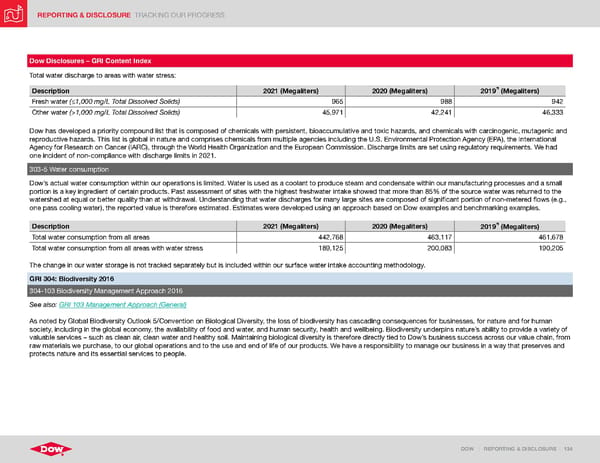REPORTING & DISCLOSURE TRACKING OUR PROGRESS DOW | REPORTING & DISCLOSURE | 134 Dow Disclosures – GRI Content Index Total water discharge to areas with water stress: Description 2021 (Megaliters) 2020 (Megaliters) 2019 (Megaliters) Fresh water (≤1,000 mg/L Total Dissolved Solids) 965 988 942 Other water (>1,000 mg/L Total Dissolved Solids) 45,971 42,241 46,333 Dow has developed a priority compound list that is composed of chemicals with persistent, bioaccumulative and toxic hazards, and chemicals with carcinogenic, mutagenic and reproductive hazards. This list is global in nature and comprises chemicals from multiple agencies including the U.S. Environmental Protection Agency (EPA), the International Agency for Research on Cancer (IARC), through the World Health Organization and the European Commission. Discharge limits are set using regulatory requirements. We had one incident of non-compliance with discharge limits in 2021. 303-5 Water consumption Dow’s actual water consumption within our operations is limited. Water is used as a coolant to produce steam and condensate within our manufacturing processes and a small portion is a key ingredient of certain products. Past assessment of sites with the highest freshwater intake showed that more than 85% of the source water was returned to the watershed at equal or better quality than at withdrawal. Understanding that water discharges for many large sites are composed of significant portion of non-metered flows (e.g., one pass cooling water), the reported value is therefore estimated. Estimates were developed using an approach based on Dow examples and benchmarking examples. Description 2021 (Megaliters) 2020 (Megaliters) 2019 (Megaliters) Total water consumption from all areas 442,768 463,117 461,678 Total water consumption from all areas with water stress 189,125 200,083 190,205 The change in our water storage is not tracked separately but is included within our surface water intake accounting methodology. GRI 304: Biodiversity 2016 304-103 Biodiversity Management Approach 2016 See also: GRI 103 Management Approach (General) As noted by Global Biodiversity Outlook 5/Convention on Biological Diversity, the loss of biodiversity has cascading consequences for businesses, for nature and for human society, including in the global economy, the availability of food and water, and human security, health and wellbeing. Biodiversity underpins nature’s ability to provide a variety of valuable services – such as clean air, clean water and healthy soil. Maintaining biological diversity is therefore directly tied to Dow’s business success across our value chain, from raw materials we purchase, to our global operations and to the use and end of life of our products. We have a responsibility to manage our business in a way that preserves and protects nature and its essential services to people.
 ESG Report | Dow Page 133 Page 135
ESG Report | Dow Page 133 Page 135